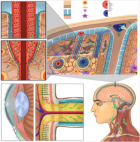About Ain Shams University
Ain Shams University
Articles by Ain Shams University
Short term effect of Intravenous Intermittent Iron Infusion versus Bolus Iron Infusion on Iron parameters in Hemodialysis patients
Published on: 21st December, 2017
OCLC Number/Unique Identifier: 7317597713
Intravenous iron is used in combination with erythropoi esis-stimulating agents to treat the anemia of hemodialysis patients, however, there is variety in the dose and the frequency. So we compare bolus intravenous iron administration protocol vs an intermittent intravenous iron infusion protocol for 3 months in a single blinded design that was conducted on 30 patients randomized into 2 matching groups. Iron parameter, hemoglobin level, and CRP were monitored before and at the end of study. Patients with end stage renal disease on regular hemodialysis with iron deficiency anemia can be treated with intravenous iron administration either by the protocol of divided doses of IV iron through the sessions of hemodialysis or by giving the total dose of iron needed as a single large dose on only one session of hemodialysis, obtaining the same outcome in correction of iron parameters in treatment of iron deficiency anemia.
Perinuclear halo indicate Trichomonas vaginalis in Pap smear
Published on: 11th January, 2019
OCLC Number/Unique Identifier: 7986007615
Trichomonas vaginalis could be seen in Pap smears where it is reported, but because main concerned is placed on malignant cells in Pap smears, not much effort is done to search for this parasite in smears. In this study, 100 cervical and vaginal specimens were examined microscopically by the conventional Papanicolaou method and liquid base cytology (LBC) for the presence of Trichomonas vaginalis (T.vaginalis). 16% were infected with T.vaginalis while 10% of diagnosis based on both perinuclear halo and T. vaginalis presence although the association between perinuclear halo and T, vaginalis is statistically insignificant it is recommended to increase the number of the cases to prove or disprove the association
Biliary reflux gastritis after Mini Gastric Bypass: The effect of Bilirubin level
Published on: 19th February, 2019
OCLC Number/Unique Identifier: 8017052074
Background: Minigastric bypass is gaining popularity worldwide as an effective bariatric surgery which has fewer complications than RYGB. There is raising concerns about biliary reflux and its effect on gastric mucosa. In this study we tried to find the link between the presence of bile in the stomach and the incidence of gastritis after MGB.
Methods: This prospective study was conducted in Ain Shams university hospitals from January 2017 to May 2018 including 40 patients. All patients underwent MGB with a 12-month follow-up, UGI endoscopy was performed 9 months after MGB for all patients, where multiple biopsies and gastric aspirate were obtained for bilirubin level
Results: Mean age at operation was 32 years (18–60) and preoperative BMI 44.31 kg/m2. The mean operative time was 95 (± 18 min), Mean % EWL was 81.2% at 12 months. Complete resolution occurred of hypertension in 8 patients (80%) and of Diabetes type 2 in 11 patients (84.2%). Level of bilirubin in gastric aspirate was elevated in 8 patients (20%) all of them had different levels pouch gastritis confirmed by histopathological examination.
Conclusion: Biliary reflux reached about 20% after MGB, the severity of biliary gastritis is related to the elevation of bilirubin level in the gastric aspirates, this results need to be confirmed by further studies on the MGB.
Correlation between interdialytic weight gain, left ventricular hypertrophy and FGF- 23 in prevalent hemodialysis patients
Published on: 28th July, 2020
OCLC Number/Unique Identifier: 8648999984
Background:Patients with end-stage renal disease are suspected to have significant volume shifts and thereby cardiovascular strain as a result to interdialytic weight gain, chronic fluid overload and fluid removal during dialysis. In long-term hemodialysis patients, higher IDWG (interdialytic weight gain) could be associated with poor survival. Patients with the lowest interdialytic weight gain have the greatest survival. Certain laboratory and imaging modalities could help to assess and monitor the appropriate fluid balance for hemodialysis patients.
FGF -23 might be associated with cardiovascular morbidity in ESRD patients.
Objective: To evaluate correlation between hypervolemia and left ventricular hypertrophy and FGF-23 in hemodialysis patients.
Patients and Methods: This cross sectional study was conducted on 60 prevalent hemodialysis patients. Patients were divided into two groups according to interdialytic weight gain (IDWG): Group I (low IDWG): Patients with absolute weight gain < 3 kg. Group II (high IDWG): patients with weight gain ≥ 3 kg. FGF 23, routine laboratory tests and echocardiography were done for both groups.
Results: high IDWG group has higher systolic blood pressure and LVMI than low IDWG group. In all patients group, FGF-23 had a positive correlation with (weight gain, Na, PO4, PTH, systolic, diastolic blood pressure, LV wall septal and posterior wall thickness and left ventricular mass index) and had a negative correlation with Hb level.
Conclusion: FGF-23 could be a marker of volume overload and LVH in ESRD patients, which affect morbidity and mortality in these patients.
FGF- 23 might be a marker of anemia in ESRD as it has a negative correlation with HB.
Systemic Lupus Erythematosus and Depression Overview
Published on: 3rd January, 2024
Systemic lupus erythematosus (SLE) is a chronic inflammatory multisystem disorder that commonly affects females during their reproductive years. It is characterized by the presence of autoantibodies and immune complex deposition, the etiology is not known but the interaction of an environmental agent in a genetically susceptible individual is thought to be fundamental. SLE most frequently involves the skin, joints, lungs, heart, kidney, and neuropsychiatric manifestations that may occur during the course of the disease. Mood disorders among SLE patients, particularly depression, are common and important psychiatric manifestations of the disease, in addition to their high incidence and possible deleterious influence on disease progression, so early identification and treatment of depression may have a significant influence on the patient’s quality of life.

HSPI: We're glad you're here. Please click "create a new Query" if you are a new visitor to our website and need further information from us.
If you are already a member of our network and need to keep track of any developments regarding a question you have already submitted, click "take me to my Query."


























































































































































